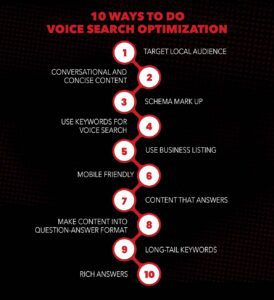Voice search is rapidly transforming the way people interact with technology and access information online. With the rise of smart speakers, virtual assistants, and mobile voice search, optimizing your website for voice search is no longer optional—it’s essential. In this comprehensive guide, we’ll explore why voice search optimization is crucial, the key strategies to implement, and how to ensure your website is ready to capture this growing traffic source.

Why Voice Search Optimization Matters
Voice search usage is skyrocketing, with millions of people using voice assistants like Siri, Google Assistant, Alexa, and Cortana to perform searches every day. According to recent studies, more than 50% of all searches will be voice-based by 2024. This shift in search behavior presents both opportunities and challenges for businesses aiming to maintain or improve their search engine rankings.
Key benefits of voice search optimization include:
- Improved User Experience: Voice search provides a faster, hands-free, and more convenient way for users to find information.
- Increased Website Traffic: Optimizing for voice search can lead to higher search engine rankings, driving more organic traffic to your site.
- Competitive Advantage: As voice search continues to grow, businesses that optimize early will have a significant advantage over competitors who lag behind.
Understanding Voice Search Queries
Voice search queries differ significantly from traditional text-based searches. Here are some key characteristics:

- Conversational Tone: Voice searches are more conversational and natural-sounding, often resembling how people speak in everyday life.
- Long-Tail Keywords: Voice queries tend to be longer and more specific, often including full sentences or questions.
- Local Intent: Many voice searches have local intent, such as finding nearby businesses or services.
High Search Volume Keywords for Voice Search
To optimize your website effectively, it’s essential to identify high search volume keywords that are commonly used in voice searches. Some examples include:
- “best restaurants near me”
- “how to fix a leaky faucet”
- “what’s the weather like today”
- “top digital marketing trends”
- “nearest coffee shop”
Strategies for Voice Search Optimization

- Focus on Conversational Keywords
To align with the conversational nature of voice search, start by incorporating long-tail keywords and natural language phrases into your content. Tools like Google’s Keyword Planner, AnswerThePublic, and SEMrush can help you identify relevant voice search queries.
Example: Instead of targeting the keyword “digital marketing trends,” optimize for phrases like “what are the top digital marketing trends in 2024” or “latest trends in digital marketing.”
- Create FAQ Pages
FAQ pages are excellent for voice search optimization because they address common questions users might ask. Structure your FAQs with direct, concise answers to improve your chances of appearing in voice search results.
Example:
- Question: “How can I improve my website’s SEO?”
- Answer: “To improve your website’s SEO, focus on creating high-quality content, optimizing for keywords, improving site speed, and building backlinks.”
- Optimize for Local Search
Given the high local intent of many voice searches, optimizing for local SEO is crucial. Ensure your business information is accurate and consistent across online directories, and claim your Google My Business listing.
Steps:
- Include your business name, address, and phone number (NAP) on your website.
- Use local keywords, such as “best Italian restaurant in [City Name].”
- Encourage customers to leave reviews on your Google My Business profile.
- Use Structured Data Markup
Implementing structured data markup (schema.org) helps search engines understand your content better, increasing the likelihood of appearing in voice search results. Use schema markup to highlight important information, such as business hours, addresses, and product details.
- Improve Page Speed and Mobile Usability
Voice searches are predominantly conducted on mobile devices, making page speed and mobile usability critical factors. Use tools like Google PageSpeed Insights and Mobile-Friendly Test to assess and improve your website’s performance.
Tips:
- Optimize images and enable browser caching.
- Minimize HTTP requests and reduce server response time.
- Ensure your website is responsive and easy to navigate on mobile devices.
- Leverage Natural Language Processing (NLP)
Search engines use NLP to understand and process voice queries. Incorporate NLP techniques into your content by writing in a natural, conversational tone and addressing user intent.
Example: Instead of writing “SEO tips 2024,” phrase it as “What are the best SEO tips for 2024?”
Creating Voice Search-Friendly Content
Creating content that ranks well for voice search requires a different approach than traditional SEO. Here are some tips to help you create voice search-friendly content:
- Answer Questions Directly Voice search queries often take the form of questions. Create content that provides direct answers to common questions in your industry.
Example:
- Question: “How do I optimize my website for voice search?”
- Answer: “To optimize your website for voice search, focus on conversational keywords, create FAQ pages, optimize for local search, use structured data markup, improve page speed, and leverage natural language processing.”
- Use Concise, Clear Language Voice search results are typically concise and to the point. Aim to provide clear, succinct answers in your content.
Example:
- Instead of: “Voice search optimization is an important aspect of SEO that involves tailoring your content and website structure to better suit voice queries.”
- Use: “Voice search optimization tailors your website for voice queries.”
- Highlight Featured Snippets Featured snippets, also known as “position zero” results, are highly valued in voice search. Structure your content to provide clear, direct answers that can be easily pulled into a featured snippet.
Example:
- Question: “What is a featured snippet?”
- Answer: “A featured snippet is a summary of an answer to a user’s query displayed at the top of Google’s search results.”
- Incorporate Natural Language Write in a conversational tone that mirrors how people speak. This makes your content more likely to match voice search queries.
Example:
- Instead of: “Utilize local keywords to enhance your website’s SEO.”
- Use: “Use local keywords to boost your site’s SEO.”
- Focus on User Intent Understand the intent behind voice queries and tailor your content to meet that intent. This involves providing comprehensive, relevant answers that address the user’s needs.
Example:
- If the query is “best coffee shops near me,” the intent is likely to find a nearby coffee shop. Your content should list and review local coffee shops.
Technical Considerations for Voice Search Optimization
In addition to content optimization, there are technical aspects to consider for voice search readiness:
- Secure Your Site with HTTPS Security is a ranking factor for Google, and HTTPS is crucial for building trust with users. Ensure your site is secured with an SSL certificate.
- Optimize for Featured Snippets Voice assistants often read out featured snippets as answers. Structure your content to be easily digestible and eligible for featured snippets by using lists, tables, and direct answers.
- Optimize for Mobile First With the majority of voice searches occurring on mobile devices, your site must be optimized for mobile. Ensure it is responsive, fast-loading, and provides a seamless user experience.
- Create Voice Search-Specific Landing Pages Consider creating landing pages specifically optimized for common voice queries related to your business. This can help you capture highly targeted traffic.
Monitoring and Measuring Voice Search Performance
It’s important to track and measure the impact of your voice search optimization efforts. Here are some key metrics and tools to use:
- Google Search Console Monitor your site’s performance in search results, track keyword rankings, and identify queries that drive voice search traffic.
- Google Analytics Analyze user behavior, track traffic sources, and measure engagement metrics to understand how voice search is impacting your site.
- Voice Search Analytics Tools Tools like SEMrush, Ahrefs, and Moz offer insights into voice search performance, including keyword rankings and featured snippet opportunities.
Future Trends in Voice Search
Voice search is continually evolving, and staying ahead of trends is crucial for maintaining your competitive edge. Here are some future trends to watch:
- Increased Use of AI and Machine Learning AI and machine learning will continue to enhance the accuracy and relevance of voice search results, making it more important than ever to focus on high-quality, user-centric content.
- Integration with IoT Devices As more IoT devices become voice-enabled, optimizing for voice search will extend beyond traditional search engines to encompass a broader range of devices and platforms.
- Voice Search in E-Commerce Voice search is set to play a significant role in e-commerce, with consumers using voice assistants to search for products, compare prices, and make purchases. Optimizing product listings and descriptions for voice search will become increasingly important.
Conclusion
Optimizing your website for voice search is no longer a futuristic concept—it’s a necessity for staying competitive in the digital landscape. By focusing on conversational keywords, creating voice search-friendly content, improving local SEO, and leveraging technical optimizations, you can ensure your website is ready to capture the growing voice search traffic.
As voice search continues to evolve, staying informed about trends and continuously adapting your strategies will be key to maintaining your search engine rankings and driving organic traffic to your site. Embrace the power of voice search optimization and position your website for success in the voice-first world.

